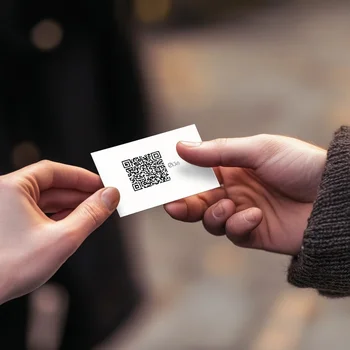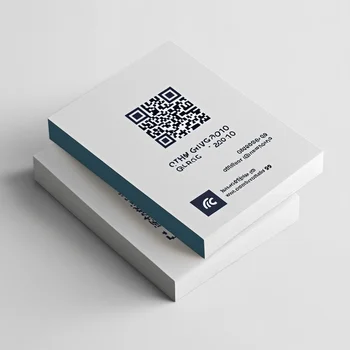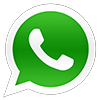In today’s digital age, where technology and traditional practices often intersect, business cards continue to hold their ground as a powerful networking tool. However, to stay relevant and make a lasting impression, it’s essential to innovate. Integrating QR codes into your business cards is one such innovation that can significantly enhance their effectiveness. This practice is becoming increasingly popular in Spain, where businesses are keen on merging the traditional with the modern.
In this article, we’ll explore how to effectively incorporate QR codes into your business cards in Spain, discussing the benefits, design considerations, and practical tips for making the most out of this technology.
The Evolution of Business Cards in Spain

Business cards have long been a staple in the Spanish business community. They serve as a personal and professional touchpoint, often exchanged during meetings, conferences, and networking events. While the design and content of business cards have evolved over time, their core purpose remains the same: to convey essential contact information and make a memorable impression.
As the digital landscape continues to expand, the need to integrate technology into traditional marketing tools has become apparent. QR codes, or Quick Response codes, offer a bridge between the physical and digital worlds, making business cards more interactive and functional.
Why Add QR Codes to Your Business Cards?
Instant Access to Digital Information
One of the primary reasons to add QR codes to your business cards is the ability to provide instant access to digital information. When someone scans the QR code with their smartphone, they can be directed to a variety of online content, such as your website, LinkedIn profile, portfolio, or even a custom landing page. This not only saves time but also ensures that your contacts have access to the most up-to-date information about your business.
Enhanced Interactivity
Adding a QR code to your business card makes it more interactive. Instead of just handing out a card, you’re giving your contacts a gateway to explore more about your business or services. This added layer of engagement can leave a stronger impression, especially in competitive markets like Spain, where standing out is crucial.
Space Efficiency
Business cards have limited space, and including all the necessary information can sometimes be challenging. QR codes help solve this problem by directing recipients to additional details online, without overcrowding the card’s design. This allows you to maintain a clean and professional look while still offering comprehensive information.
Trackable Marketing Tool
Another significant advantage of using QR codes is their trackability. By linking the QR code to a trackable URL, you can gain insights into how many people are engaging with your card, when they are scanning it, and from which locations. This data can be invaluable for refining your marketing strategies and understanding your audience better, particularly in a diverse market like Spain.
Designing Business Cards with QR Codes in Mind
While the benefits of QR codes are clear, it’s essential to incorporate them into your business cards thoughtfully. Here are some key design considerations:
Placement of the QR Code
The placement of the QR code on your business card is crucial. It should be easily visible but not overpowering. Typically, QR codes are placed on the back of the card, allowing the front to focus on your name, logo, and essential contact details. However, depending on your card’s design, you can also place it on the front, ensuring it complements rather than distracts from the other elements.
Size and Scannability
The QR code must be of sufficient size to be easily scannable. A common mistake is making the QR code too small, which can result in difficulty scanning and a frustrating user experience. Generally, a size of at least 2 x 2 cm is recommended, but you should always test the scannability of the code before finalizing your design.
Color and Contrast
While QR codes are traditionally black and white, you can customize their color to match your brand identity. However, it’s essential to maintain a high contrast between the QR code and the background to ensure it remains scannable. In Spain, where bold and vibrant designs are often favored, integrating your brand colors into the QR code can enhance its visual appeal while still being functional.
Including a Call-to-Action
Simply adding a QR code to your business card isn’t enough; you should also include a call-to-action (CTA) that encourages people to scan it. A short phrase like “Scan to connect” or “Explore more online” can guide recipients on what to do next, making it more likely that they’ll engage with your digital content.
Practical Applications of QR Codes on Business Cards
QR codes on business cards can serve various purposes, depending on your business needs. Here are some practical applications:
Link to Your Website or Online Portfolio
Directing people to your website or online portfolio is one of the most common uses for QR codes on business cards. This is particularly useful for professionals in creative industries, freelancers, or entrepreneurs in Spain, where showcasing your work online can significantly impact your business success.
Connect on Social Media
Another popular use is linking the QR code to your social media profiles, such as LinkedIn, Twitter, or Instagram. This allows contacts to connect with you instantly on platforms where you regularly engage and share content. In Spain’s vibrant social media landscape, this can be an effective way to build and maintain professional relationships.
Share Contact Information
QR codes can also be used to share your digital contact information via a vCard. When someone scans the code, your contact details are automatically added to their phone’s address book, eliminating the need for manual entry and ensuring your information is saved correctly.
Promote Special Offers or Events
If you’re hosting an event or offering a special promotion, you can use the QR code to direct people to a dedicated landing page with more details. This can be particularly effective in Spain, where events and promotions are often key drivers of business engagement.
Legal and Cultural Considerations in Spain

While QR codes are widely accepted in Spain, it’s essential to be aware of certain legal and cultural considerations when incorporating them into your business cards.
Data Protection Compliance
Spain has strict data protection laws, and it’s crucial to ensure that any data collected via QR codes is handled in compliance with regulations like the General Data Protection Regulation (GDPR). If your QR code links to a form or landing page that collects personal information, make sure to include a privacy policy and obtain explicit consent from users.
Cultural Sensitivity
When designing your business cards, it’s important to consider cultural sensitivities. In Spain, business culture tends to value personal relationships and face-to-face interactions. While QR codes can enhance your business card, they should not replace the personal touch that is often appreciated in Spanish business dealings. Ensure that your card still reflects your willingness to connect personally, with the QR code serving as an additional resource.
Final Thoughts: Making Your Business Cards Stand Out in Spain
Integrating QR codes into your business cards can significantly enhance their effectiveness, providing a seamless bridge between the physical and digital worlds. By thoughtfully designing your cards with QR codes that align with your brand and business goals, you can create a powerful marketing tool that resonates in Spain’s dynamic market.
As you consider upgrading your business cards, think about how you can make a lasting impression. BusinessCardsSpain offers custom-designed business cards with QR code integration, ensuring that your cards are not only visually appealing but also highly functional. Connect with us today to elevate your business presence in Spain’s competitive landscape.

